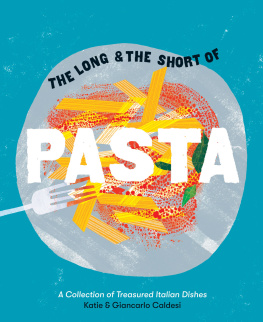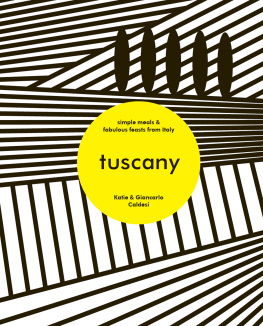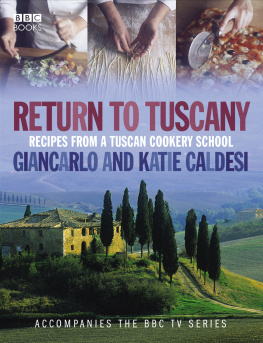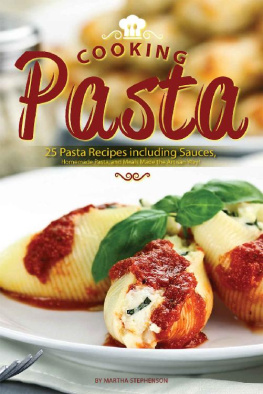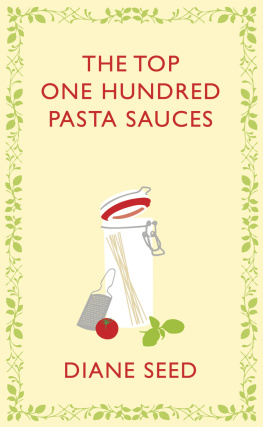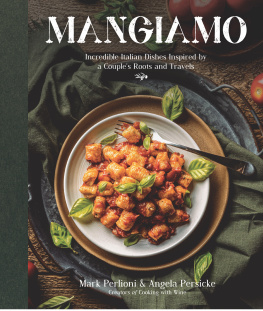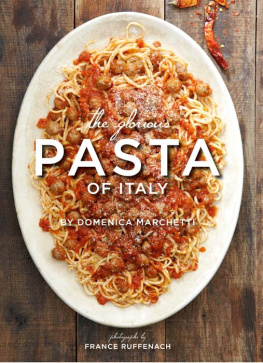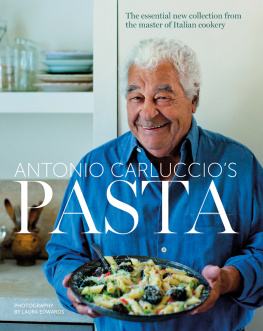OTHER BOOKS BY KATIE & GIANCARLO CALDESI:
The Amalfi Coast: A Collection of Italian Recipes
Venice: Recipes Lost and Found
Rome: Centuries in an Italian Kitchen
Sicily: Recipes from an Italian Island
Tuscany: Simple Meals & Fabulous Feasts from Italy
RECIPE NOTES
Unless otherwise stated: all fruit and vegetables are medium-sized; all fruit and herbs are fresh; all eggs are free-range and medium-sized.
All olive oil used in this book is extra-virgin olive oil.
Raw or lightly cooked eggs should be avoided by pregnant women, the elderly and very young children.
Recipes that contain nuts should be avoided by those with a known allergic reaction to nuts and nut derivatives.
Oven temperature: these are given for fan ovens. If you are using a conventional oven, increase the heat by around 20C (you can also check with the manufacturers handbook).
CONTENTS
Pasta is a feeling as well as a fuel. In our opinion there is nothing quite so satisfying to eat as a bowl of hot pasta clinging to a rich, intense sauce from the aroma of the sauce warming in the pan, the look of a dish that will surely quash your hunger to the first bite into al dente pasta that slides easily from fork to mouth.
No one can say for sure where pasta appeared first in the world. In its basic form it is a mixture of flour and water and as such could have been thought of by many people.
Although Marco Polo may have seen noodles on his visits to China it was already in Italy before he came back. At Cerveteri near Rome, we have seen Etruscan tomb paintings which show a bowl with flour and water, a rolling pin and even a cutting wheel dating to the 4th century BC. The Ancient Roman writer Apicius described making lagana, a forerunner to lasagne made from cooked sheets of flour and water. The famous ndunderi a type of gnocchi made from flour and cheese from Minori are from an ancient, possibly Roman recipe and have even been recognized by Unesco as one of the first types pasta.
In 1154 AD an Arab geographer, Al-Idrisi, wrote of strands of pasta made in Sicily, it was a technique introduced by the Arabs from Palestine. The lengths of pasta were dried and exported in huge quantities from Norman Sicily. There are documents dating from 1371 that reveal that the prices of macaroni and lasagne in Palermo were triple those of bread. As such it was a food enjoyed mostly by the aristocracy and the Jewish population.
Pasta was originally eaten with hands but the addition of sauces led to the widespread use of the table fork. In Medieval Italy ravioli was a popular dish often containing herbs and spices, mixed with cheese and eggs, then cooked in broth and finished with more spice and sometimes sugar. Lasagne too, would be coated with sugar and spice. Couscous, which are tiny beads of pasta was also brought to Sicily by the Arabs and is still made along the west coast of the island.
Lunch is the time in Tuscany to eat pasta. In most households you will find pots of rag or tomato sauce in the fridge for such a time. We sometimes have a ball of leftover pasta dough in the fridge, so all I need to do is quickly roll it through the pasta machine and drop the strands into boiling water for a couple of minutes to make a quick lunch. However, dried pasta is perfectly acceptable and its quick cooking time makes it ideal for a meal when you have little time for preparation. Many Italians also eat it in the evening, or late into the night. Giancarlo remembers preparing un spaghettata in the early hours of the morning after a night of dancing: he would cook pasta and serve it with a little chilli, splashes of new olive oil, a handful of chopped parsley and some of the local sheeps cheese.
ACCORDING TO A STUDY OF GLOBAL FOOD TRENDS PASTA IS THE WORLDS FAVOURITE FOOD
The nutrition
According to a study of global food trends by Oxfam pasta is the worlds favourite food and a group of pasta producers has now proclaimed 25th October as World Pasta Day. Celebrations take place all over the world to recognise this combination of protein and carbohydrate that is both filling and inexpensive. With the addition of a sauce containing protein such as a rag or fat such as olive oil, pasta will sustain you for a good few hours.
Pasta is relatively low on the GI scale amongst other carbohydrates, the glycaemic index shows the effect that carbohydrates have on our blood sugar levels. Cooking it al dente means that the release of sugar into the blood will happen more slowly than it would with overcooked pasta. And if you cool the pasta after cooking it and then either reheat it or eat it cold it will be even lower as some of it will become resistant starch that cannot be digested by our bodies so you will absorb fewer calories. Resistant starch is also good for our guts as it feeds the good bacteria.
By making your own sauces you can avoid the sugar-laden commercial alternatives and fussy-eaters will often tuck into carrots, onions and celery disguised in tomato sauces or rag without realising they are eating vegetables. It is however worth remembering that in Italy pasta is served in small portions as a starter and never in huge bowls as we have become used to in the rest of the world.
What to eat if you don't or cant eat pasta?
Giancarlo was hit with a double whammy when his doctor told him some years ago he not only had Type 2 diabetes but was also gluten-intolerant. Pasta is a treat for him now and has to be gluten-free. After much experimentation we found the recipe on works brilliantly for stuffed or ribbons of pasta. To avoid the spike of glucose in his blood from carbohydrate we have been really happy to discover vegetable pasta as an alternative.
Just because Mamma would never have had her rag with anything but freshly made ribbons of pasta doesnt mean that her son couldnt enjoy his rag (on .
Difference between dried and fresh pasta
Italians dont judge fresh or dried as better they are just different. Generally fresh pasta is made with egg and flour and dried pasta is made with water and flour but there are some anomalies such as or dried egg pasta usually sold in cardboard cartons to protect its fragile form.
All pasta in Giancarlos household was fresh until the 1950s when dried pasta came onto the market and his mum was no longer tied to the kitchen table making it every day. I am sure she loved her new found freedom and time saving packets of spaghetti. However she and many other Italians never lost their love of freshly made pasta. Southern regions such as Sicily eat less fresh pasta than their northern counterparts and when it is made in the south it frequently contains semola flour and no egg in contrast to the rich egg pasta from the north.

